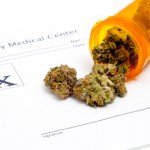Last evening I glanced at the table of contents of the New England Journal of Medicine and was somewhat surprised to find there was an article online on medical marijuana.It discussed a hypothetical patient with metastatic breast cancer who had considerable pain issues and had asked her primary care physician if she could use pot to relieve her pain, nausea and fatigue. There were pro and con discussants with a psychiatrist from the Mayo Clinic in favor of "thoughtful prescription of medicinal marijuana," but wanting those to occur within established doctor-patient relationships.
That latter comment made sense to me; if medical marijuana (AKA Cannabis) is recommended by a physician, it should be by a doctor who knows that particular patient well, not someone who writes Rx's for dozens of people a day in a "pain mill."
On the other side of the issue were a Clinical Professor of Psychiatry at Georgetown University (a former White House Drug Czar) teamed with the Chief of the Pain Management Services at a Florida University. They noted that most of the research efforts have focused on specific chemicals from the marijuana plant and that there is limited, but high-quality, data supporting relief of some kinds of pain by smoking pot, but not the type of pain the patient being discussed had. They mentioned two prescription "cannabinoids" that are currently FDA-approved as oral agents specifically for the treatment of nausea/vomiting secondary to chemotherapy.
There have been over a hundred comments to date in the online discussion of the article. One was from a Colorado anesthesiologist/acute pain specialist who commented that patients who use marijuana on a daily basis may become cross-tolerant to opiate drugs, therefore requiring much higher and more dangerous doses of them to have a desired effect in pain control.
A major issue remains the 1970 classification of marijuana as a Controlled Substance Schedule 1 drug, therefore, putting it into the company of heroin, LSD and mescaline, chemicals that have a high potential for abuse and a lack of any medical value.
To date eighteen states have legalized physicians to prescribe the drug, but Federal policy lags far behind and, in theory, docs who write Rx's for marijuana could face legal action. In Israel, on the other hand, over 10,000 patients use marijuana under government license according to a July, 2012 NPR article.
I found an online article titled "How Marijuana Works." This comes from one of the HowStuffWorks websites, not a medical publication, but seems fairly well balanced. It mentions that cultivation of marijuana is not at all new, with written reports in China dating back over 2,000 years. The plant apparently came from India where it can grow to heights over 13 feet. It contains an enormous number of chemicals, over 400 of them with 60 falling into the cannabinoid group. The National Cancer Institute's webpage on Cannabis and Cannabinoids define these as chemicals that activate specific receptors found throughout the body to produce drug-like effects.
So what's a receptor? I read a superb analogy in Discover magazine with science writer Gary Taubes comparing them to miniature locks on the surface of cells, locks that can only be opened with the correct chemical key.
Cells, including those involved in immunity and the central nervous system, have receptors that bind with substances such as hormones, antigens, drugs, or neurotransmitters (brain chemicals that communicate information from nerve cells). Two different kinds of receptors, termed CB1 and CB2, bind with cannabinoids. The CB1 receptor, when triggered, causes the drug high; THC (the full chemical name is delta-9-tetrahydrocannabinol) is primarily the cannabinoid that leads to this effect. A March, 2012 study from the Mount Sinai School of Medicine focused on the CB2 receptor after research showed that a medication that triggered only CB2 might prove a significant adjunctive treatment to standard anti HIV therapy in late-stage disease.
Other articles in the medical literature discuss the use of marijuana versus cannabinoids in glaucoma therapy. Smoking marijuana lowers intraocular pressure in roughly two-thirds of glaucoma patients. One issue, however, is smoking marijuana is smoking and in end-of-life care probably poses acceptable risks, but done in other situations it may cause a host of problems. Other means of administration include drinking raw cannabis juice, the use of inhalers or administering only specific active cannabinnoids.
In my state, Colorado, there's an organization, headed by an attorney and calling itself Sensible Colorado, that has advocated for medial marijuana. One of their websites outlines the "History of Colorado's Medical Marijuana Laws." Over thirteen years ago our voters passed Amendment 20 to the state constitution, legalizing limited amounts of marijuana for patients and their primary caregivers.
The statute listed the diseases for which a person could be prescribed marijuana/cannabinoids. The first group included cancer, HIV/AIDS and Glaucoma. As I read background articles I could see some reason behind those choices. I'm less impressed with data on most of the other reasons to give the drug to patients.
In 2000, Colorado voters support the legalization of medical marijuana. In our city and around the state there followed a proliferation of "pot shops," without a great deal of unified regulation. Some cities were stricter in their approach toward the sale of marijuana than others.
All this may have been overcome by events; I'll write about the recent changes in the law in my next post.



